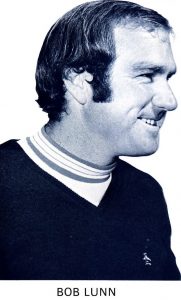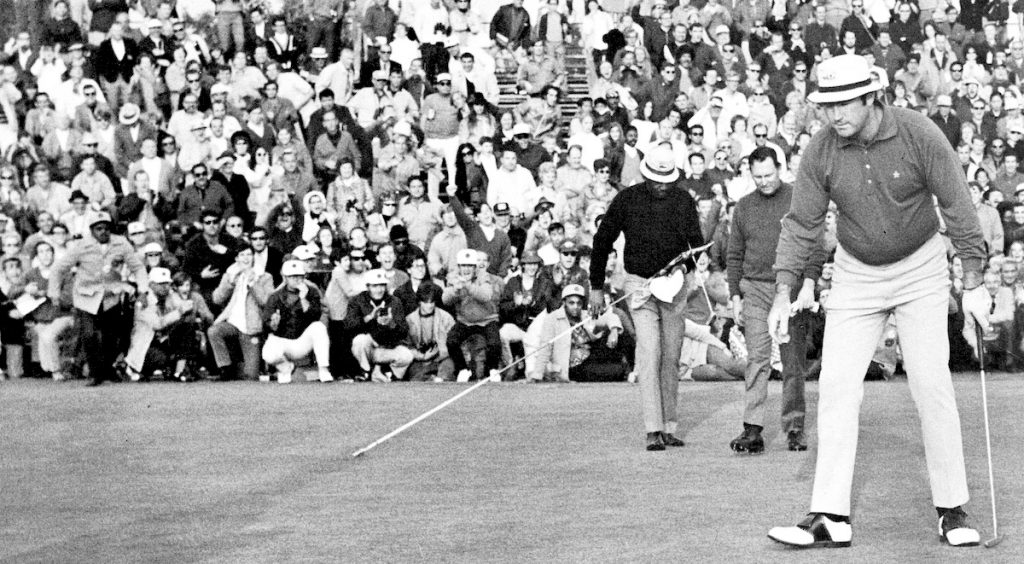In 1971, the 45th Los Angeles Open was renamed the Glen Campbell Los Angeles Open.
According to course manager Si Wasserman, the Rancho Golf Course was in the middle of $300,000 worth of major improvements. Tee’s were enlarged and re-seeded; a new driving range fence was installed with sound baffles; and six new “sand traps” were added “to make an already difficult course even more challenging,” and the Rancho restaurant was renovated to be “on a par with the finest of any public facility.”
“Some 70 palm “trees” have been placed at strategic spots to improve the landscaping. Hundreds of young trees have been planted at appropriate locations to provide a beautiful background.”

San Francisco municipal golfer Robert “Bob” Lunn had missed a playoff with Billy Casper and Hale Irwin in the 1970 L.A. Open by one stroke and was ready for another chance in 1971. Coincidentally, Lunn won the USGA Public Links championship in 1963, the same “major” that Rancho had hosted for its grand opening in 1949.
Note: For all professional golf competitions at Rancho Park the nine’s were reversed.
From the 1972 Glen Campbell Los Angeles Open Press Book:
RESUME OF THE 1971 LOS ANGELES OPEN
The tradition-rich Los Angeles Open has seen surprisingly few playoffs during its 45 years. But the law of averages has begun to catch up in the last three years, each of which produced a sudden-death playoff.In 1971, Bill Casper, who won such a decider from young Hale Irwin in 1970, lost out to husky Bob Lunn in a tense, four-hole playoff.
Lunn 25, and the veteran Casper, 39, tied at the end of the regulation 72 holes with eight-under-par 274s. Veteran Art Wall almost made it a three-way playoff but three-putted the 72nd hole to finish one shot back of Lunn and Casper.
The Lunn-Casper playoff started on the 15th hole and they battled all the way to the 18th before a decision was reached. There, Lunn put his approach shot 18 inches from the flag while Casper was on the back of the green.
Billy made a good attempt for his birdie but just failed. Lunn then rolled in the putt to take the $22,000 first prize and another big step in his career.
(From the 1972 L.A. Open Press Book.)
The 1971 Open was close and competitive all the way. Virtually unknown Bobby Greenwood led by three shots entering the final 18 but couldn’t handle the pressure and slipped to a 73, which netted him a tie for fourth place.

Here is Bob Lunn’s story by Shav Glick, from the 1972 L.A. Open program:
BOB LUNN – DEFENDING CHAMPION
At first glance Bob Lunn appears to be a big, burley fellow who could pass for the town bully in a “B” Western.
But he’s really as emotional as a puppy.
Bob’s first win on a golf course came when he was an 18-year old public links golfer from Sacramento. He won the 1963 U.S. Public Links championship on the Haggin Oaks Course in his hometown, defeating Steve Opperman, 1 up, in the finals.
“When that last little putt dropped into the cup,” said Lunn, I couldn’t keep the tears back. And l thought I was going to be sick.”
A few years later he was making $100,000, on the PGA tour, but he hadn’t lost his sentimental altitude.
Last January, after defeating defending champion Billy Casper in a sudden-death playoff for the Glen Campbell Los Angeles Open here at Rancho Park, he was the same old Bob Lunn, a little older and a little bigger, but still the same.
“I’m so happy I could cry – and I probably will,” he said as he accepted a check for $22,000 from Los Angeles Junior Chamber of Commerce officials.
Lunn’s entry into professional golf was as uneventful as his high school career when he didn’t win a tournament. In his first year, 1967, he played in 27 events and won only $1,871 in “official” money. However, he picked up a nice “unofficial” check for $ 6,660 when he teamed with another rookie Rich Martinez of San Clemente to finish second in the Haig and Haig Scotch Foursome tournament.
His success in the November Haig and Haig at La Costa carried over into 1968 when Lunn soared into the $ 100,000 bracket and, was selected by Golf Digest as the “most improved professional of the year.” Bob started off with a fourth place finish in the Andy Williams San Diego Open, worth $7,500, but he won money in only three of his first 12 tournaments. Then, in May, he won back-to-back tour victories at Memphis and Atlanta, becoming the first player in history to follow his initial tour victory with another the following week.
Buoyed with confidence from his fine sophomore year, Lunn started 1969 by winning the $ 31,000 Southern California Open at Los Coyotes. It was the start of another big year for the big fellow from Sacramento. In 1970 he earned $101,685, his second year over the hundred thousand figure.
During the Glen Campbell L.A. Open last year Lunn decided that too much of his earnings were going to his waistline. He had ballooned to 240 pounds during the holiday season and he felt a diet was necessary.
“The extra weight didn’t hurt my game in any way that l could tell,” said Lunn, “but l figured I didn’t need it. l was afraid from a health standpoint.”
Lunn lost 10 pounds during the four rounds here at Rancho and decided that, as long as he won the tournament, he would lose some more. Pretty soon it developed into an obsession and by mid-April he was down to 175 pounds.
“While I didn’t notice any appreciable change in my game, I couldn’t relax off the course,” he admitted later. His wife, a beautiful brunette named Angie, noticed the difference. “He’s too quick to snap at little things.” she confided. “He’s just not like himself .”
When things go wrong for Lunn he turns to Tom LoPresti, the man who gave him his start as a professional, backing him to the tune of $ 250 a week during the early years.
Lunn called LoPresti in Sacramento when the tour reached Atlanta and Tom, a former pro himself, flew to Georgia to help straighten him out.
“After I played one round with Bob I knew his game had gone to pot. He wasn’t consistent off the tee, he shanked some shots and he couldn’t concentrate at all on the greens. I figured he’d lost too much weight too fast and I talked him out of his diet. I convinced him to start eating again, especially foods heavy in dextrose and protein.”
Now Bob is back up close to the 200 pound mark again and hitting the ball with his high, wide and handsome swing. He finished second in the Heritage Golf Classic last month to lift his earnings to $ 82,179 for 1971.
Lunn has had little difficulty preparing himself for defense of the Glen Campbell Los Angeles Open. He is one who loves to practice.
“When l’m not in a tournament I play only about 18 holes a week, but I try to get in at least two hours of practice every day,” he once said. “That’s just as much fun as playing. I love to just stand there and hit those balls.”
He hits them a long way, too. In a stretch of 21 tournaments where IBM charted every drive of every professional, Lunn averaged 268 yards. Only DeWitt Weaver, Jack Nicklaus and Marty Fleckman were longer.
Now that Bob’s weight is back up, there’s very little to distinguish him from the young fellow who started out on the tour six years ago – except his bankroll. Once Bob was asked what difference success had made to him.
“It’s funny, the other guys are letting me tell my stories now. They used to bore me with their own,” he answered.
If he can win the Glen Campbell Los Angeles Open again this week he’ll have a whole lot more to talk about. No one has scored back-to-back wins in this tournament since Arnold Palmer accomplished the feat in 1966-67.
And if he does, he’ll probably cry, too.
Shav Glick, from the 1972 L.A. Open program
©2022 Jib Jones golfhistoricalsociety
